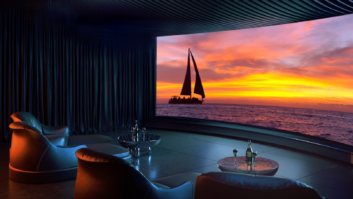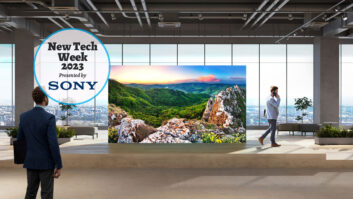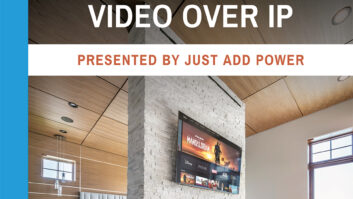Let’s Get Rid of Arcane Aspect Ratio and Resolution Numbers

Anthony Grimani ([email protected]) is president of PMI Ltd., an award-winning home cinema engineering firm (www.pmiltd.com).
I am absolutely baffled by the way we sell our video features and technologies. We know that our client base isn’t interested in mathematical formulas, yet we keep dishing out a dizzying array of divisions and coded language to describe why they should get excited about the latest and greatest in visual display quality. Clients that are confused by arcane aspect ratio and screen resolution numbers are clients that are not buying video products.
Who ever thought that consumers would get excited about something called 16:9? Are we going to get everybody knocking on our doors because they think 21:9 is better, or because they can dream about 4K instead of 1080p screen resolution?
Let’s Clarify
I know that we are dealing with a lot of legacy rationales for all these numbers. Take aspect ratios, for instance. The 1.33333 ratio (rounded to 1:33), which is also known as 4:3, came about from the way that Edison and Kodak made their early films. The Academy of Motion Picture Arts and Sciences later set this aspect ratio as its standard for shooting and displaying movies in the early 20th century.

We need to stop listening to our engineers for marketing and branding terms and start coming up with simpler methods for our end users to figure out the progression in video performance and quality.
The 1.77778 (rounded to 1.78) “HDTV ratio,” which is also known as 16:9, resulted from a 1984 study to determine how wide versus tall manufacturers could make CRT picture tubes before TV sets would become unmanageably large for the screen size. By the time HDTV really got going, CRTs were on the way out and the transition to fixed-pixel displays was well under way.
The 2.35 aspect ratio (yes, that’s 21:9) is a survivor of Hollywood’s widescreen revolution of the 1950s, when Twentieth Century Fox branded the anamorphic photographic process used to create it as CinemaScope. For various technical reasons the original “Scope” aspect ratio of 2.55:1 has been narrowed to 2.35 (or thereabouts).
And then there’s resolution… In the analog days we used to specify horizontal resolution in MHz (number black-white-black transitions a display could resolve) and vertical resolution in number of lines. Now we’ve got a lot of pixels everywhere, but no consistency in how we account for them. The 720p (1280 x 720) and 1080p (1920 x 1080) resolution designations are named for their vertical pixel count. Meanwhile 2K (2048 x 1566) and 4K (4096 x 2160) Digital Cinema formats are known by their horizontal pixel count. Do we seriously need to burden our client presentations–and their focus on the final experience–with long division and inconsistent terminology?
And Simplify
We need to stop listening to our engineers for marketing and branding terms and start coming up with simpler methods for our end users to figure out the progression in video performance and quality.
First off, for aspect ratios, let’s just use the ratio number and not a division process. That shows up clearly by just glancing. The progression would look something like this:
1.33
1.78
2.35
In this approach, the larger the number equates to the wider (better) presentation. Note that, in reality, there are also common film formats such as 1.66 and 1.85, but these aren’t setting standards for equipment and native screen construction.
Second, for resolutions, let’s all go with one direction, and stick to it. It looks like the analog legacy of counting vertical lines no longer makes sense, so let’s all agree to count horizontal resolution in pixels. This would look like:
640 (640 x 480 SD 1.33 Ratio Pictures)
2K (1920 x 1080 HD 1.78 Ratio Pictures)
4K (Upcoming 4096 x 2160 Pictures)
Note that I am omitting the number for 1280×720 because, here again, this is not really a relevant measure of display systems we would be specifying and selling into our projects. I know that there are subtleties between the home video versions of 1920 x 1080 vs. the digital cinemaresolution of 2048 x 1556, but I don’t believe this will impact our clients and our communication one bit.
4K to the Rescue
Digital Cinema’s 4K presents the ultimate solution, as projectors with 4096 x 2160 pixels will be able to accommodate all the common resolutions and aspect ratios without the complicated and expensive addition of video processors and anamorphic optics to stretch, scale, multiply, and squeeze. Any time you add things like this to the video path, you introduce the potential for quality loss and optical degradation. For now, we need to work on keeping the terminology as simple and straightforward as possible, and look forward with great anticipation to this new crop of displays that will allow both ultimate flexibility. With some luck, networking pipelines will be large enough in the near future to gives true 4K resolution without undue compression and bandwidth limiting, and we’ll be able to give our clients images on screens large enough to subtend 50 degrees of field of vision with 2.35:1 images.
Chase Walton contributed to this column.







